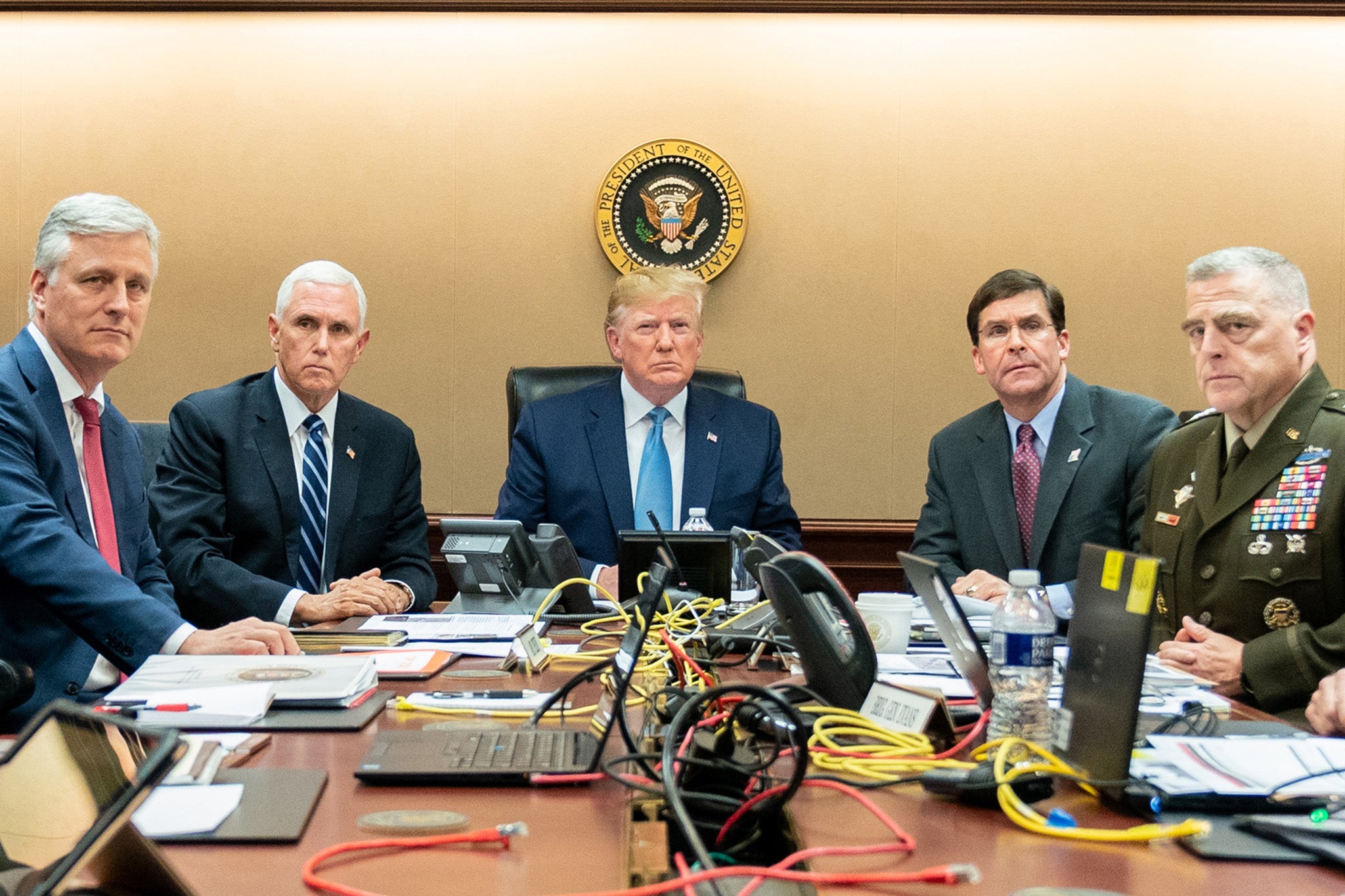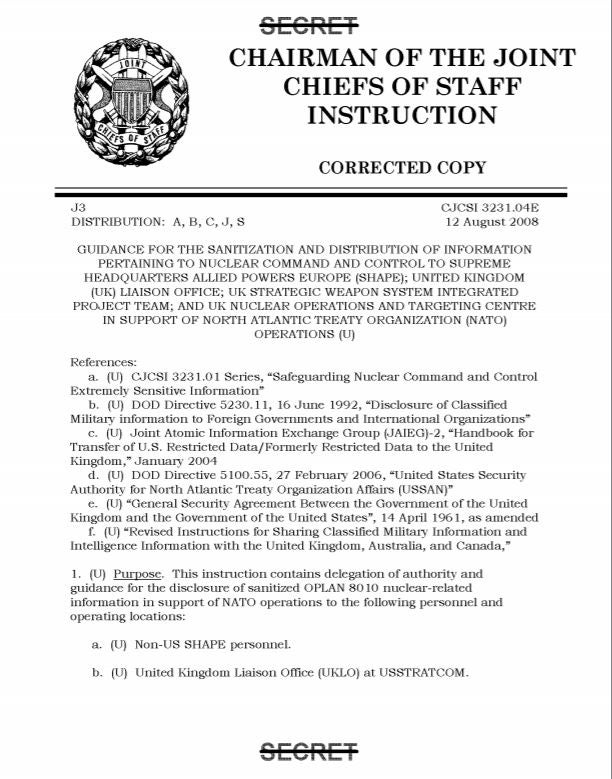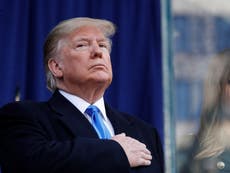Could Trump push the red button before he leaves office?
Never more than a few feet away from him, the president has the means to launch a nuclear attack. And the temptation in the next few weeks will be greater than ever, says Chris Horrie


Donald Trump’s decision to fire Defence Secretary Mark Esper on Tuesday removed one of the final barriers between the president and his ability to launch the US arsenal of nuclear missiles on his own authority without consultation and perhaps even without warning. The US president is required to consult with his defence secretary before making a decision to fire nuclear weapons. But if the defence secretary objects he can be over-ruled. The president retains ultimate and sole control because he can sack the defence secretary in the event of disagreement.
The only other person who could prevent the president from ordering a nuclear attack would be Vice President Mike Pence, through the indirect means of declaring Trump to be insane and removing him from office. Section four of the 25th amendment to the US constitution would allow Pence to do this, but he would require the unanimous support of the cabinet. Nobody thinks that Pence would defy Trump in this way. And the Trump cabinet has an overwhelming majority of his supporters, apparently selected more for their personal loyalty to him than their expertise or backbone.
The departure of Esper, originally brought into the cabinet as yet another loyalist – he had previously worked as a lobbyist for arms manufacturers – and the relative lack of standing of his replacement, Christopher C Miller, means that the last hurdle between Trump and the doomsday command has been removed.
This development has caused widespread alarm. Even senior Republican Party figures such as Marco Rubio have said Trump should not be trusted with sole control of the nuclear codes because he is “an erratic individual”. But according to experts the likely result of Trump trying to launch the missiles in a fit of rage is that he would not be obeyed. This would amount to a sort of military coup and would cause a constitutional crisis and yet more general chaos and political mayhem in the American system.
Earlier this year William J Perry – secretary of defence in the Clinton administration – published a book called The Button, about the way in which policy and protocols for the use of US nuclear weapons have evolved over the years. Perry wants to move authority for use of nuclear weapons from the president to a panel of experts, along the lines of a jury. This is the case, he says, in Russia for example, where not even Vladimir Putin can authorise a nuclear strike without the agreement of a council of experts.
The record of past leaders may have made the Russians wary of giving the nuclear codes to just one person, the head of state. President Boris Yeltsin, for example, had a problem with drink and heart medication and was not always compos mentis. The rumours were confirmed when Yeltsin was found by the US secret service during a state visit to Washington blind drunk in the middle of the night trying to hail a taxi in Pennsylvania Avenue dressed only in his underpants.
Bill Clinton, the man whom Yeltsin was visiting, had meanwhile lost US launch codes in the similar way that you or I might misplace our car keys. The president was so embarrassed by this blunder that he did not tell the secret service for months.
According to General Hugh Shelton, chairman of the Joint Chiefs of Staff in the Clinton administration, the president would come over all shifty when told he had to hand over the codes so they could be changed for routine security reasons: he would say he was too busy in a meeting and would deal with it later. Thus the entire US nuclear missile force was knocked out of operation because Clinton didn’t want to appear stupid in front of subordinates and nobody else had the authority to authorise the use of nuclear weapons. Clinton’s management of the nuclear codes, Shelton said, had been “a comedy of errors”.
President Nixon ended his last days as president in a state of mental collapse and exhaustion, deeply paranoid and dependent on sleeping pills and booze, wandering the corridors of the White House talking to the portraits of former presidents. Earlier in his presidency Nixon had tried to order a tactical nuclear strike on North Korea when he was drunk, but was not able to carry out the order to completion.
President Trump famously does not drink. But he is – or was – taking cortiscosteroids to treat Covid-19. Common side-effects of this medicine include mood swings from anxiety and paranoia to bursts of aggression and feelings of invulnerability. There are as yet no reports of him talking to the portraits. Trump’s behaviour since the election though has been decidedly odd and unpredictable, even by his own standards.
Previous presidents have regarded the football as a sort of horrifying, sobering momento mori and a constant reminder of the gravity of their position
Trump, as Commander in Chief of US forces, could authorise the use of nuclear weapons and would not need to consult anybody unless he wanted to.
Each morning, alongside the daily intelligence summary, he is given a small sealed wallet containing a plastic card similar to a credit card, displaying rows of numbers. The card is nicknamed The Biscuit. The biscuit displays a series of “gold code” numbers which – following the Clinton episode – are provided by the Pentagon and are updated every day.
To launch a nuclear war the president would simply snap open the wallet, read the day’s gold numbers and combine them with a further set of numbers he memorised when he took office. He would use the combined code to establish his identity. This dual system and the daily updates were introduced after the Clinton debacle and were designed to render the codes useless if the card was lost or pickpocketed by, for example, Monica Lewinsky, Stormy Daniels or the KGB.
By this stage the president should have consulted the nuclear options set out in a document called OPLAN 80-10. These range from a supposedly limited or tactical nuclear strike through to a launch-everything-at-everyone Dr Strangelove option.
Bits of this document have been obtained by the Federation of American of Scientists using the Freedom of Information Act. Most of the options appear to be directed against Russia, China, North Korea, Iran, Syria and “Weapons of Mass Destruction Attacks by non-state actors” – meaning terrorists. Numerous plans are drawn up and updated by the Pentagon, pre-programmed and, to coin a phrase, “oven ready”. They combine different numbers and types of nuclear missiles and different lists of targets. The president would simply select his choice a la carte.
The OPLAN 80-10 handbook, known as The Black Book, is kept in a special metal briefcase nicknamed The Nuclear Football, which also contains communications equipment, un-jammable, blast-proof phones and the like. The Football is carried by one of the president’s security team, and is never more than a few feet away from him, 24/7.
Earlier this year CNN reported that the president carries the football in a buggy next to his clubs when he plays golf. Previous presidents have regarded the football as a sort of horrifying, sobering momento mori and a constant reminder of the gravity of their position. Trump in contrast arranged for a paying guest at his Mar-a-Lago resort to be photographed standing next to it smiling with his thumbs up as a souvenir of his visit.
President Trump can authorise a nuclear attack from Mar-a-Lago or anywhere else he happens to be in the world at any time, but nuclear planning assumes he would want to do this not from the golf course or his gold-plated toilet in Trump Tower, but from the White House Situation Room, a purpose-built bunker in the basement of the West Wing. The bunker is equipped to receive all the latest detailed information from the CIA, military intelligence, nuclear early warning systems, electronic intercepts and top quality, reliable secret intelligence gleaned from around the world – at a vast cost to the US taxpayer.
The Black Book is known to include a pre-existing list of targets in Iran and is causing concern in Washington. The attack plans aimed against Russia, China and even North Korea would entail the danger of a counter-strike since these powers have missiles which can reach the continental US. North Korea does not have missiles capable of reaching Washington or New York – but the regime might have developed the capacity to hit California and definitely has missiles with which to deliver a nuclear strike on Japan and South Korea, including the US forces stationed there. Further, it is possible that China – which does not possess intercontinental range missiles – would launch a nuclear counter-strike against the US on behalf of North Korea.
The political temptation for Trump could be great. It would bring an immediate and historic end to the Iranian revolutionary regime, and ensure the Napoleonic or Churchillian scale of attention he appears to crave when it comes to the history books
Iran would have no means of striking back directly at the US, though Trump would have to make sure that the Russians or Chinese did not respond on their behalf. Essentially, Trump would need the permission of Vladimir Putin to launch an attack on Iran. The political temptation for Trump could be great. It would, if nothing else, bring an immediate and historic end to the Iranian revolutionary regime, and ensure the Napoleonic or Churchillian scale of attention he appears to crave when it comes to the history books.
The cost, however, would be millions of Iranian civilian deaths and casualties, and pariah status for the US around the world for decades. If Trump wanted to attack Iran without clearing it first with Putin he would have to prepare for at least the possibility of a retaliatory Russian nuclear missile attack. As it happens there is already an extensive and supposedly fool-proof set of arrangements to deal with such an eventuality, developed in the long dark decades of the cold war when such an attack seemed at least possible, if not likely.
In the event of a nuclear attack against the US, the first missiles would be launched from Russian submarines just of the east coast and would land on the White House, Washington and New York within 15 minutes. The president, in the company of the Nuclear Football, would travel from the White House in Marine One – one of a fleet of more than 30 presidential helicopters – to Andrews airforce base. The 11-mile journey takes about four minutes. Marine One always flies in a squadron of five identical helicopters, which act as decoys to reduce the probability of the president being shot down. (The multiple helicopters fuels a popular but untrue conspiracy theory that there are two Melania Trumps – one being a stunt double – and that they are deployed at different events at different times for the same terrorist-confounding reasons).

Safely on board Airforce One, the president would take the Black Book from The Football, select his choice of nuclear attack, confirm his ID by using the Biscuit and instruct the Chairman of the Joint Chiefs of Staff, General Mark A Milley to carry it out.
At this point the nuclear option moves out of the hands of the president to the military, which will carry out the plan come what may, even if Airforce One is shot down and the president killed. The decision would have moved from the realms of discussion, politics and judgement to rapid implementation – no questions asked. The president would have no further role to play.
General Milley would be in the driving seat, directing the staff of the US Strategic Command HQ located at Offutt Airbase in remote Nebraska, just about as far from the now blazing and irradiated cities of metro US that it is possible to get. Strategic command would then transmit coded launch signals from their war room at Offutt. Minutes later, according to plan, dozens of submarines, aircraft carriers, missile silos and bombers who would launch their missiles.
This would not be the first time a nuclear attack has been launched from Offutt. In 1945 the Enola Gay was built and loaded at Offutt with the atom bomb which was dropped on Hiroshima. The mission was the origin of the nuclear age and of US strategic command.
Stanley Kubrick’s satirical cold war masterpiece, Dr Strangelove, was set in a fictional airforce base in the middle of nowhere, but based on Offutt. The film features General Jack Ripper – an unstable Trump-like egomaniac who transmits the launch codes because he believes that Russia is exercising mind control over Americans by means of water fluoridation. In the ensuing panic various military leaders ensconced in the darkened bunker begin arguing, resulting in the immortal line: “Gentlemen, please – no fighting in the war room.”
The question is, would Milley carry out the president’s order? Experts suspect that he would be more likely to resign or to directly refuse to obey. This would amount to mutiny
Things at Offutt have not always gone smoothly in reality. In a grimly ironic turn of events that not event Kubrick could have imagined, Offutt last year was flooded by the nearby Missouri river, rendering it inoperable, and thus proving General Milley’s advice to Trump and to Congress that climate change was a bigger threat to the US national security than the possibility of nuclear attack. But even when the base is not under six feet of water, psychological, morale and discipline problems are rife among officers and men responsible for maintaining and launching the missiles.
The Strategic Command codes that would order an immediate launch are kept in a safe next to the silo containing each missile and are received by missile launching crews known as The Rough Riders. The official motto is “Poised for Peace”. Each missile has a crew of at least four officers and enlisted airmen. Two crew members have to use separate keys to open the safe. As an added precaution at least one of the crew has to be armed, and is trained to shoot any other member of the crew if they go crazy and attempt to launch a missile without permission or, more likely, try to prevent the launch of a missile once a legitimate instruction has been received.
In reality, demoralisation, indiscipline and breaches of security are frequent. Missile crews are required to take regular psychological tests to ensure they are mentally stable.
In 2014 dozens of officers were sacked after it was found they had been cheating in the aptitude tests, passing the required answers around between themselves on the internet. The previous year 90 missile crew at various bases were dismissed for illegal drug use after a crackdown, and 17 other officers were dismissed for safety violations of one sort or another. A further 10 senior officers and base commanders were sacked for failing to provide proper leadership of the crews. There can be as many as four of these sorts of scandals in a single year. The work is so boring and the likelihood of a genuine launch code being received so slight, that crews are apt to go to sleep on the job, especially on the night shift, leaving one of their number on guard.
The question is, would Milley carry out the president’s order? Experts suspect that he would be more likely to resign or to directly refuse to obey. This would amount to mutiny, or even a type of military coup, unless he was sure that the US was under nuclear attack. This is Perry’s point – that giving sole power over use of nuclear weapons to a single person, the president, is more likely to result in an even more ruinous political crisis than an insane decision by a crazed president.
One result would be a period when nobody was officially in charge of the nuclear force, and nobody had the authority to use them which, according to the deterrence theory which justified the possession of nuclear weapons, would invite or at least greatly increase the threat of immediate nuclear attack, since the US would be unable to retaliate.
These sort of worries prompted Congress last year to examine the exclusive presidential power to launch nuclear weapons for the first time in 40 years. A former commander of US strategic military command, Robert C Kehler, gave evidence that if he was asked to launch a nuclear attack there were circumstances where he would refuse, unless the order was legal. In international law almost all use and threatened use of nuclear weapons could be deemed to be illegal, since use would inevitably entail large number of civilian casualties.
Nuclear deterrence has always been asserted to be a matter of power and necessity, rather than legality. When asked, therefore, what would happen if the Chairman of the Joint Chiefs of Staff refused to obey an order Kehler simply shrugged and said: “I don’t know.” The committee laughed.
It would seem that General Milley would certainly resign rather than launch a nuclear strike at the behest of Trump. The main reason is that unlike all of the loyalist political appointees Trump has brought into the defence department this week, Milley has autonomy gained from his position as a non-political career military leader and manager who has risen through the ranks.
Milley is not scared to stand up to Trump. Earlier this year he annoyed the president by criticising his use of the military to suppress Black Lives Matter protests in Washington – the same instance of ‘disloyalty’ that motivated Trump to sack Defence Secretary Esper this week. Milley also embarrassed Trump during the election campaign, by publicly objecting to the use of his name and reputation in Trump’s re-election advertising.
Milley has also tried, without success, to get the Trump Pentagon to develop military plans to respond to threats from climate change and pandemics. Milley might therefore be considered to be the nuclear equivalent of Dr Fauci – loathed by Trump but probably impossible to sack because of his professional standing.
It should be a considerable cause for relief that amid the chaos and confusion in Washington and the White House at the moment that the man who really has his finger on the button looks much more like Dr Fauci than Dr Strangelove.




Join our commenting forum
Join thought-provoking conversations, follow other Independent readers and see their replies
Comments